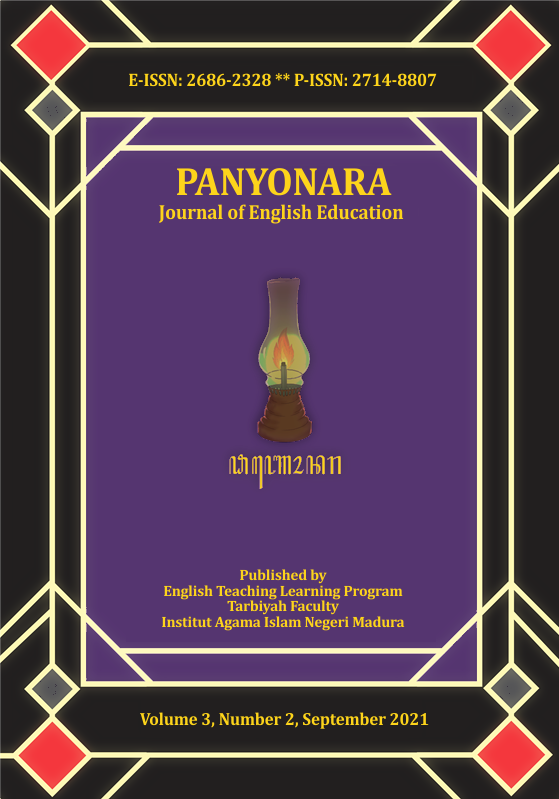Teaching Reading Through KWL (Know-Want to know-Learned) Strategy In Islamic Economics Text
 Abstract views: 375
,
Abstract views: 375
,
 PDF downloads: 419
PDF downloads: 419
Abstract
KWL strategy is a reading strategy used by teachers or educators to improve the students' reading skills by activating their prior knowledge, encouraging their motivation, and making the student comprehend the text holistically. The purpose of this research is to (1) apply the K-W-L Strategy in Reading Islamic Economics Text (2) know How do the students apply the K-W-L strategy in reading Islamic economics text. This research is conducted in a descriptive qualitative design. The data is collected by observation and documents. Data analysis procedure based on Creswell, Rossman & Marshall, 1) Organizing and familiarizing 2) Coding and reducing 3) Interpreting and representing. The results present that the application of K-W-L strategy is made through three steps, namely 1) Pre-reading, where the teacher or researcher created a good condition of the classroom and introducing passage, and the students filling the chart in K column 2) Whilst reading, the teacher leads the student read the text and started to write down what they want to learn in W column 3) Post-reading in which the students started to comprehend the passage, make a conclusion and stated what they have learned from text based on their comprehension in L column. The study also concluded that the KWL strategy was appropriate in teaching reading on Islamic Economics Text, and it can be applied in reading for any level of English learners.
Downloads
References
Ary, D., Jacobs, L. C., Razavieh, A., & Ary, D. (2010). Introduction to research in education (8th ed). Belmont, CA: Wadsworth.
Blachowicz, C. L. Z., & Ogle, D. (2002). Reading Comprehension: Strategies for Independent Learners. New York: Guilford Press.
Bowen, G. A. (2009). Document Analysis as a Qualitative Research Method. Qualitative Research Journal, 9(2), 27–40. doi: 10.3316/QRJ0902027
Carrell, P. L., & Grabe, W. (2013). Reading. Dalam N. Schmitt (Ed.), An Introduction to Applied Linguistics. London: Routledge.
Creswell, J. W. (2012). Education Research. Boston: Pearson Education.
Florence, F. O., Adesola, O. A., Hameed, B. A., & Adewumi, O. M. (2017). A Survey on the Reading Habits among Colleges of Education Students in the Information Age. Journal of Education and Practice, 8(8), 106–110.
Grabe, W. (Ed.). (2008). The Nature of Reading: Defining Reading. Dalam Reading in a Second Language: Moving from Theory to Practice (hlm. 4–20). Cambridge: Cambridge University Press. doi: 10.1017/CBO9781139150484.004
Grabe, W. (2009). Reading in a Second Language. New York: Cambridge University Press.
Guthrie, J. T., Wigfield, A., & VonSecker, C. (2000). Effects of Integrated Instruction on Motivation and Strategy Use in Reading. Journal of Educational Psychology, 92(2), 331–341. doi: 10.1037/0022-0663.92.2.331
Hidayat, L. E. (2016). Picto-Text Glosses to Enhance Students’ Reading Comprehension. OKARA: Jurnal Bahasa dan Sastra, 10(2), 167–176. doi: 10.19105/ojbs.v10i2.977
Hudson, T. (2011). Teaching Second Language Reading. Oxford: Oxford University Press.
Husna, N. (2017). Practicing Critical Thinking through Extensive Reading Activities. Dalam Ideas for 21st Century Education (1 ed., hlm. 17–21). Routledge. doi: 10.1201/9781315166575-3
Klack, S. K. (2014). Writing Strategies for Science. Huntington Beach: Shell Education.
Latief, M. A. (2011). Research Methods on Language Learning: An Introduction. Malang: University Negeri Malang Press.
Latief, M. A. (2014). Tanya jawab Metode Penelitian Pembelajaran Bahasa. Malang: UM Press.
Macceca, S. (2014). Reading Strategies for Social Studies. Huntington Beach: Shell Education.
McNamara, D. S. (2007). Reading Comprehension Strategies: Theories, Interventions, and Technologies (hlm. xv, 520). Mahwah, NJ, US: Lawrence Erlbaum Associates Publishers.
Nunky, A. (2016). The Effectiveness of K-W-L (Know-Want-Learnt) Technique on Students’ Reading Comprehension of Descriptive Text. Universitas Islam Negeri Syarif Hidayatullah Jakarta, Jakarta.
Ogle, D. M. (1986). K-W-L: A Teaching Model that Develops Active Reading of Expository Text. Dalam J. M. Mason & K. H. Au (Ed.), Reading Instruction for Today (2 ed.). Broadway: Harper Collins Publisher Ltd.
Riswanto, Risnawati, & Lismayanti, D. (2014). The Effect of Using KWL (Know, Want, Learned) Strategy on EFL Students’ Reading Comprehension Achievement. International Journal of Humanities and Social Science, 4(7), 225–233.
Ros, C., & Vaughn, S. (2002). The Know, Want to Know, Learn Strategy. Dalam K. D. Muth (Ed.), Children’s Comprehension of Text: Research into Practice. Newark: International Reading Association.
Rossman, G. B., & Marshall, C. (1995). Designing Qualitative Research (2 ed.). London: SAGE Publications.
Sugiyono. (2009). Metode Penelitian Kuantitatif dan Kualitatif dan R & D. Bandung: Alfabeta.
Tsaqib, N. (2017). The Effectiveness Between Survey, Question, Read, Recite, Review (SQ3R) and Know, Want, Learn (KWL) Strategy to Increase Students’ Reading Comprehension. IAIN Salatiga, Salatiga.
Urquhart, A. H., & Weir, C. J. (1998). Reading in a Second Language: Process, Product and Practice. London: Longman.
Waring, R., & Husna, N. (2019). Expectations and Experiences of Indonesian Teachers who Have, and Have not, Done Extensive Reading. TEFLIN Journal, 30(2), 153–170. doi: 10.15639/teflinjournal.v30i2/153-170
The journal uses an Open Access policy under a Creative Commons Attribution-NonCommercial 4.0 International License. Authors who publish with this journal agree to the following terms:
- Authors retain copyright and grant the journal right of first publication with the work simultaneously licensed under a Creative Commons Attribution License that allows others to share the work with an acknowledgment of the work's authorship and initial publication in this journal.
- Authors are able to enter into separate, additional contractual arrangements for the non-exclusive distribution of the journal's published version of the work (e.g., post it to an institutional repository or publish it in a book), with an acknowledgment of its initial publication in this journal.
- Authors are permitted and encouraged to post their work online (e.g., in institutional repositories or on their website) prior to and during the submission process, as it can lead to productive exchanges, as well as earlier and greater citation of published work.
















